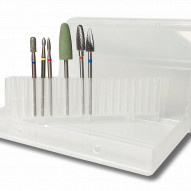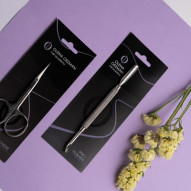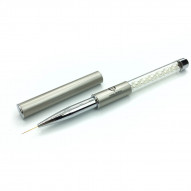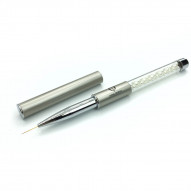COURSE CONTENT:
- Intro- My experiences and secrets that are often not given.
- Forms - Types, requirements and what to consider.
- Paper - The advantages and disadvantages of paper forms.
- The cut-out and the shapes of the forms
- The print and the markings
- Tunnel - Influence the tunnel using the positioning of the form.
- The middle roundness and metal plate
- Scissors and position - How to determine good scissors.
- Glossary -General terms I will be using in this course.
- 3D Finger - Explore the points located on the natural nail.
- Alignment and axis - Explain the lines and their uses.
- Analyzing the nails - What helps us adjust the form correctly.
- Structure - The positioning of the nail form which varies.
- Natural nail preparation - How to prepare before the form.
- Lateral Sides - How the lateral sides influence the side cuts.
- Natural nail preparation - Prepare the nails for the form.
- Analyzing the nails - Important for a nice result.
- The depth - How to measure the necessary width and depth.
- Side cuts - How to make the cuts correctly to fit the nail.
- The batman and mistakes - Explain what a Batman is.
- Cutting and holding - What makes a good scissors for the form.
- The mickey mouse - Explain what a micky mouse is.
- The angle - How the form can assist us in this point.
- How to choose the form - More detail into the forms shape.
- Hypohidrosis - Apply the form on clients with sweaty hands.
- How to pinch - How to pinch without additional pinching tools.
- Pre exercise explanation -What to expect in the next 5 videos!
- Exercise 1-5 - Exercises for a perfect cut.
- Pre application explanation - What to expect in the next videos!
- Application on flat nails
- Application on rounded nails with small lateral sides
- Application on rounded nails that are deeply embedded
- Application on wide nails with very big lateral sides
- Application on fanned nails with pronounced sides
- Application on fanned nails that are flat and embedded
- Application on how to use metal plates
- Application on over filed nails with an uneven free edge
- Application on different nail plates without side pre-cuts
- Application on long nail plate with pronounced hyponichium
- Quiz - Let's check the level of knowledge you gained!
- Exclusive workbook

INFORMATION ABOUT THE COURSE:
Explanations of when, how and why we cut a form. Examples, how and where you
can apply this knowledge. I will show you how the right cut influences the sculpturing
and changes the appearance and durability of the nails. In different case studies I explain to you the differences for each cut.
However, all this knowledge would be of little use without exercises and links.
In a separate workbook I have compiled practical and helpful exercises for you,
to help you recognize the special features of the nails, train your eye and cut the form perfectly.
Trainers in nail design
As a Trainer, I know how important it is to keep learning. Many trainer colleagues do not accept other trainers in their own training courses. I don’t agree with this. Unfortunately, over the last few years, since my Academy exist, the information has been misused several times, especially by trainer colleagues. Information and workbooks were passed to others online, in own classes without mentioning the source. It lead to the decision to change the sales policy. The price for trainer colleagues is changed which should be understandable and need no further explanation. If passing the information to your students, especially when using any printing material, videos or unique information a source must be mentioned. I ask you to accept this conditions and be respectful.
Feedback from our
students
These cookies are used for the functionality of the site and should not be turned off. The data collected from users is not shared with third parties and is used solely for the functionality of the site, to display videos and to ensure the use of PayPal.
These cookies are used to make the use and functionality of the site more appealing to you.
These cookies are used to calculate the page views and traffic. This allows us to make changes and improvements to our site. These cookies are used to analyse which pages are used the most and how the visitor "moves" on the page. The cookies for advertising and targeting are created in cooperation with the advertising partners and help to track and analyse the interests of the visitors.
Save settings More information












